What's inside
What's inside
 Key Ingredients
Key Ingredients

 Benefits
Benefits

 Concerns
Concerns

 Ingredients Side-by-side
Ingredients Side-by-side

Sodium Hyaluronate
HumectantZanthoxylum Bungeanum Fruit Extract
Skin ConditioningPalmitoyl Tripeptide-5
Skin ConditioningPanthenol
Skin ConditioningPseudoalteromonas Ferment Extract
HumectantAlgae Extract
EmollientTocopherol
AntioxidantSqualene
EmollientSodium Phytate
Potassium Sorbate
PreservativePantolactone
HumectantMaltodextrin
AbsorbentXanthan Gum
EmulsifyingOleyl Phosphate
EmulsifyingHydrogenated Lecithin
EmulsifyingPhenethyl Alcohol
MaskingEthylhexylglycerin
Skin ConditioningSodium Benzoate
MaskingCaprylyl Glycol
EmollientBeta-Sitosterol
Emulsion StabilisingSodium Phosphate
Buffering1,2-Hexanediol
Skin ConditioningTropolone
Skin ConditioningPhenoxyethanol
PreservativeCitric Acid
BufferingParfum
MaskingSodium Hyaluronate, Zanthoxylum Bungeanum Fruit Extract, Palmitoyl Tripeptide-5, Panthenol, Pseudoalteromonas Ferment Extract, Algae Extract, Tocopherol, Squalene, Sodium Phytate, Potassium Sorbate, Pantolactone, Maltodextrin, Xanthan Gum, Oleyl Phosphate, Hydrogenated Lecithin, Phenethyl Alcohol, Ethylhexylglycerin, Sodium Benzoate, Caprylyl Glycol, Beta-Sitosterol, Sodium Phosphate, 1,2-Hexanediol, Tropolone, Phenoxyethanol, Citric Acid, Parfum
Water
Skin ConditioningC10-18 Triglycerides
EmollientCaprylic/Capric Triglyceride
MaskingHeptyl Undecylenate
EmollientGlycerin
HumectantPropanediol
SolventEthylhexyl Palmitate
EmollientGlyceryl Stearate
EmollientPEG-100 Stearate
Butylene Glycol
HumectantSodium Citrate
BufferingMaltodextrin
AbsorbentHydroxyethyl Acrylate/Sodium Acryloyldimethyl Taurate Copolymer
Emulsion StabilisingArginine PCA
HumectantCetyl Alcohol
EmollientGluconolactone
Skin ConditioningHydrogenated Olive Oil Stearyl Esters
Emulsion StabilisingMannitol
HumectantParfum
MaskingSucrose Dilaurate
EmollientMaris Aqua
HumectantSimmondsia Chinensis Seed Oil
EmollientTribehenin
EmollientSucrose Palmitate
EmollientHydroxyacetophenone
AntioxidantCaprylyl Glycol
EmollientCitric Acid
BufferingSodium Hydroxide
BufferingPolyacrylate Crosspolymer-6
Emulsion StabilisingSodium Cocoyl Glutamate
CleansingTocopherol
AntioxidantHelianthus Annuus Seed Oil
EmollientLecithin
EmollientLysolecithin
EmulsifyingGlyceryl Linoleate
EmollientPaeonia Albiflora Root Extract
Skin ConditioningPrunus Amygdalus Dulcis Oil
Skin ConditioningPisum Sativum Extract
Skin ConditioningPolysorbate 60
EmulsifyingSorbitan Isostearate
EmulsifyingSodium Chloride
MaskingBorago Officinalis Seed Oil
EmollientOenothera Biennis Oil
EmollientCamellia Oleifera Seed Oil
Skin ConditioningCI 77891
Cosmetic ColorantSynthetic Fluorphlogopite
Trihydroxystearin
Skin ConditioningNiacinamide
Smoothing3-O-Ethyl Ascorbic Acid
Skin ConditioningLactobacillus Ferment
Skin ConditioningPotassium Azeloyl Diglycinate
Skin ConditioningSodium Phytate
Ceramide NP
Skin ConditioningSodium Hyaluronate
Humectant1,2-Hexanediol
Skin ConditioningGlucose
HumectantPhenoxyethanol
PreservativeBisabolol
MaskingPotassium Chloride
Beta-Sitosterol
Emulsion StabilisingPhytic Acid
Squalene
EmollientPotassium Sorbate
PreservativeCalcium Chloride
AstringentSophora Japonica Flower Extract
Skin ProtectingAcetyl Tetrapeptide-11
Skin ConditioningMagnesium Sulfate
Glutamine
Skin ConditioningAcetyl Tetrapeptide-9
Skin ConditioningTin Oxide
AbrasiveCI 19140
Cosmetic ColorantSodium Phosphate
BufferingAscorbic Acid
AntioxidantSodium Acetate
BufferingLysine Hcl
Skin ConditioningArginine Hcl
Skin ConditioningAlanine
MaskingCI 17200
Cosmetic ColorantHistidine Hcl
Skin ConditioningValine
MaskingLeucine
Skin ConditioningThreonine
Isoleucine
Skin ConditioningTryptophan
MaskingPhenylalanine
MaskingTyrosine
MaskingGlycine
BufferingPolysorbate 80
EmulsifyingGlucomannan
Skin ConditioningSerine
MaskingCystine
MaskingCyanocobalamin
Skin ConditioningGlutathione
Asparagine
MaskingAspartic Acid
MaskingOrnithine Hcl
Skin ConditioningGlutamic Acid
HumectantNicotinamide Adenine Dinucleotide
Skin ConditioningProline
Skin ConditioningMethionine
Skin ConditioningTaurine
BufferingHydroxyproline
Skin ConditioningGlucosamine Hcl
Coenzyme A
Skin ConditioningSodium Glucuronate
HumectantThiamine Diphosphate
Skin ConditioningRetinyl Acetate
Skin ConditioningInositol
HumectantNiacin
SmoothingPyridoxine Hcl
Skin ConditioningBiotin
AntiseborrhoeicCalcium Pantothenate
Riboflavin
Cosmetic ColorantSodium Tocopheryl Phosphate
AntioxidantThiamine Hcl
MaskingFolic Acid
Skin ConditioningWater, C10-18 Triglycerides, Caprylic/Capric Triglyceride, Heptyl Undecylenate, Glycerin, Propanediol, Ethylhexyl Palmitate, Glyceryl Stearate, PEG-100 Stearate, Butylene Glycol, Sodium Citrate, Maltodextrin, Hydroxyethyl Acrylate/Sodium Acryloyldimethyl Taurate Copolymer, Arginine PCA, Cetyl Alcohol, Gluconolactone, Hydrogenated Olive Oil Stearyl Esters, Mannitol, Parfum, Sucrose Dilaurate, Maris Aqua, Simmondsia Chinensis Seed Oil, Tribehenin, Sucrose Palmitate, Hydroxyacetophenone, Caprylyl Glycol, Citric Acid, Sodium Hydroxide, Polyacrylate Crosspolymer-6, Sodium Cocoyl Glutamate, Tocopherol, Helianthus Annuus Seed Oil, Lecithin, Lysolecithin, Glyceryl Linoleate, Paeonia Albiflora Root Extract, Prunus Amygdalus Dulcis Oil, Pisum Sativum Extract, Polysorbate 60, Sorbitan Isostearate, Sodium Chloride, Borago Officinalis Seed Oil, Oenothera Biennis Oil, Camellia Oleifera Seed Oil, CI 77891, Synthetic Fluorphlogopite, Trihydroxystearin, Niacinamide, 3-O-Ethyl Ascorbic Acid, Lactobacillus Ferment, Potassium Azeloyl Diglycinate, Sodium Phytate, Ceramide NP, Sodium Hyaluronate, 1,2-Hexanediol, Glucose, Phenoxyethanol, Bisabolol, Potassium Chloride, Beta-Sitosterol, Phytic Acid, Squalene, Potassium Sorbate, Calcium Chloride, Sophora Japonica Flower Extract, Acetyl Tetrapeptide-11, Magnesium Sulfate, Glutamine, Acetyl Tetrapeptide-9, Tin Oxide, CI 19140, Sodium Phosphate, Ascorbic Acid, Sodium Acetate, Lysine Hcl, Arginine Hcl, Alanine, CI 17200, Histidine Hcl, Valine, Leucine, Threonine, Isoleucine, Tryptophan, Phenylalanine, Tyrosine, Glycine, Polysorbate 80, Glucomannan, Serine, Cystine, Cyanocobalamin, Glutathione, Asparagine, Aspartic Acid, Ornithine Hcl, Glutamic Acid, Nicotinamide Adenine Dinucleotide, Proline, Methionine, Taurine, Hydroxyproline, Glucosamine Hcl, Coenzyme A, Sodium Glucuronate, Thiamine Diphosphate, Retinyl Acetate, Inositol, Niacin, Pyridoxine Hcl, Biotin, Calcium Pantothenate, Riboflavin, Sodium Tocopheryl Phosphate, Thiamine Hcl, Folic Acid
Alternatives
Ingredients Explained
These ingredients are found in both products.
Ingredients higher up in an ingredient list are typically present in a larger amount.
1,2-Hexanediol is a synthetic liquid and another multi-functional powerhouse.
It is a:
- Humectant, drawing moisture into the skin
- Emollient, helping to soften skin
- Solvent, dispersing and stabilizing formulas
- Preservative booster, enhancing the antimicrobial activity of other preservatives
Beta-Sitosterol is a plant-derived fatty acid with a structure similar to cholesterol (which naturally occurs in skin). It helps hydrate the skin and stabilize formulations.
This ingredient can be naturally found in fruits, veggies, nuts, and seeds.
Caprylyl Glycol is a humectant and emollient, meaning it attracts and preserves moisture.
It is a common ingredient in many products, especially those designed to hydrate skin. The primary benefits are retaining moisture, skin softening, and promoting a healthy skin barrier.
Though Caprylyl Glycol is an alcohol derived from fatty acids, it is not the kind that can dry out skin.
This ingredient is also used as a preservative to extend the life of products. It has slight antimicrobial properties.
Learn more about Caprylyl GlycolCitric Acid is an alpha hydroxy acid (AHA) naturally found in citrus fruits like oranges, lemons, and limes.
Like other AHAs, citric acid can exfoliate skin by breaking down the bonds that hold dead skin cells together. This helps reveal smoother and brighter skin underneath.
However, this exfoliating effect only happens at high concentrations (20%) which can be hard to find in cosmetic products.
Due to this, citric acid is usually included in small amounts as a pH adjuster. This helps keep products slightly more acidic and compatible with skin's natural pH.
In skincare formulas, citric acid can:
While it can provide some skin benefits, research shows lactic acid and glycolic acid are generally more effective and less irritating exfoliants.
Most citric acid used in skincare today is made by fermenting sugars (usually from molasses). This synthetic version is identical to the natural citrus form but easier to stabilize and use in formulations.
Read more about some other popular AHA's here:
Learn more about Citric AcidMaltodextrin is a polysaccharide. It is derived from starch such as rice, corn, wheat, or potato starch.
In food, Maltodextrin is used to improve the texture and thicken a product. Due to its structure, it can help create a gel texture. As an emulsion stabilizer, it helps keep the ingredients in a product together.
As a polysaccharide, Maltodextrin has moisturizing properties. Polysaccharides are a type of carbohydrate. The top layer of skin uses polysaccharides to retain water, keeping the skin hydrated.
Maltodextrin is water soluble and has a sweet taste.
Learn more about MaltodextrinParfum is a catch-all term for an ingredient or more that is used to give a scent to products.
Also called "fragrance", this ingredient can be a blend of hundreds of chemicals or plant oils. This means every product with "fragrance" or "parfum" in the ingredients list is a different mixture.
For instance, Habanolide is a proprietary trade name for a specific aroma chemical. When used as a fragrance ingredient in cosmetics, most aroma chemicals fall under the broad labeling category of “FRAGRANCE” or “PARFUM” according to EU and US regulations.
The term 'parfum' or 'fragrance' is not regulated in many countries. In many cases, it is up to the brand to define this term.
For instance, many brands choose to label themselves as "fragrance-free" because they are not using synthetic fragrances. However, their products may still contain ingredients such as essential oils that are considered a fragrance by INCI standards.
One example is Calendula flower extract. Calendula is an essential oil that still imparts a scent or 'fragrance'.
Depending on the blend, the ingredients in the mixture can cause allergies and sensitivities on the skin. Some ingredients that are known EU allergens include linalool and citronellol.
Parfum can also be used to mask or cover an unpleasant scent.
The bottom line is: not all fragrances/parfum/ingredients are created equally. If you are worried about fragrances, we recommend taking a closer look at an ingredient. And of course, we always recommend speaking with a professional.
Learn more about ParfumPhenoxyethanol is a preservative that has germicide, antimicrobial, and aromatic properties. Studies show that phenoxyethanol can prevent microbial growth. By itself, it has a scent that is similar to that of a rose.
It's often used in formulations along with Caprylyl Glycol to preserve the shelf life of products.
Potassium Sorbate is a preservative used to prevent yeast and mold in products. It is commonly found in both cosmetic and food products.
This ingredient comes from potassium salt derived from sorbic acid. Sorbic acid is a natural antibiotic and effective against fungus.
Both potassium sorbate and sorbic acid can be found in baked goods, cheeses, dried meats, dried fruit, ice cream, pickles, wine, yogurt, and more.
You'll often find this ingredient used with other preservatives.
Learn more about Potassium SorbateSodium Hyaluronate is hyaluronic acid's salt form. It is commonly derived from the sodium salt of hyaluronic acid.
Like hyaluronic acid, it is great at holding water and acts as a humectant. This makes it a great skin hydrating ingredient.
Sodium Hyaluronate is naturally occurring in our bodies and is mostly found in eye fluid and joints.
These are some other common types of Hyaluronic Acid:
Learn more about Sodium HyaluronateSodium phosphate is a group of inorganic sodium salts (mono, di, and tri-sodium phosphate). It has pH buffering, chelating, and stabilizing properties.
This means it helps maintain a formula's acidity, enhances preservative performance, and prevents unwanted changes caused by metal ions or hard water.
Sodium phosphate is considered safe for use in cosmetics according to the Cosmetic Ingredient Review (CIR); it also has a long-established food-grade safety rating as well.
Though some sources claim sodium phosphate can help "energize skin cells", this claim is not strongly supported by independent scientific studies.
Learn more about Sodium PhosphateSodium Phytate is the synthetic salt form of phytic acid. Phytic acid is an antioxidant and can be found in plant seeds.
Sodium Phytate is a chelating agent. Chelating agents help prevent metals from binding to water. This helps stabilize the ingredients and the product.
Squalene is naturally found in plants and animals, including our skin and sebum. It is a lipid our bodies naturally produce and makes up about 10-12% of the oil on our skin. Our skin produces squalene to keep itself naturally hydrated.
This ingredient is a potent antioxidant and can help fight against skin damage.
Sources of squalene include olives and rice bran. Some sources may be animals such as from shark liver.
Squalane comes from squalene and is created using hydrogenation. Squalane is lighter than squalene.
Hydrogenation is the conversion from unsaturated oil to saturated oil. This makes squalane more stable and have a longer shelf life than squalene.
Read more about squalane with an "a".
Learn more about SqualeneTocopherol (also known as Vitamin E) is a common antioxidant used to help protect the skin from free-radicals and strengthen the skin barrier. It's also fat soluble - this means our skin is great at absorbing it.
Vitamin E also helps keep your natural skin lipids healthy. Your lipid skin barrier naturally consists of lipids, ceramides, and fatty acids. Vitamin E offers extra protection for your skin’s lipid barrier, keeping your skin healthy and nourished.
Another benefit is a bit of UV protection. Vitamin E helps reduce the damage caused by UVB rays. (It should not replace your sunscreen). Combining it with Vitamin C can decrease sunburned cells and hyperpigmentation after UV exposure.
You might have noticed Vitamin E + C often paired together. This is because it is great at stabilizing Vitamin C. Using the two together helps increase the effectiveness of both ingredients.
There are often claims that Vitamin E can reduce/prevent scarring, but these claims haven't been confirmed by scientific research.
Learn more about Tocopherol